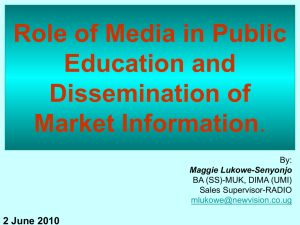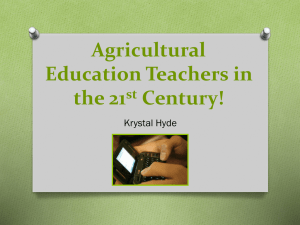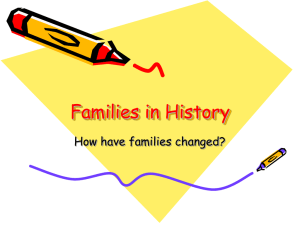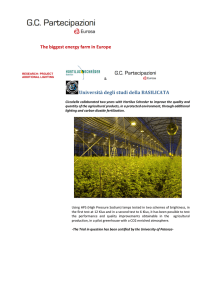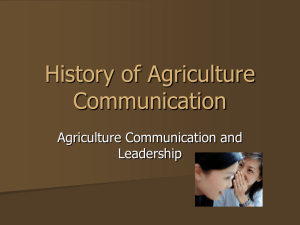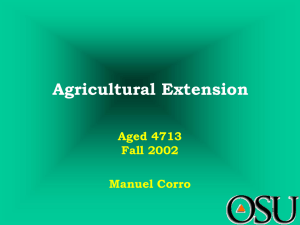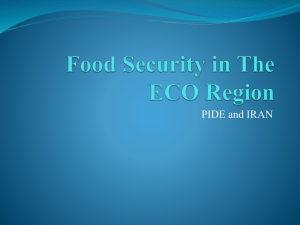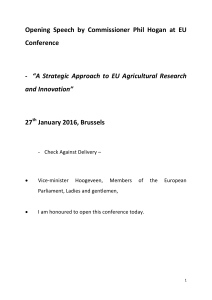Andrea Bohn - E- AG Conference
advertisement
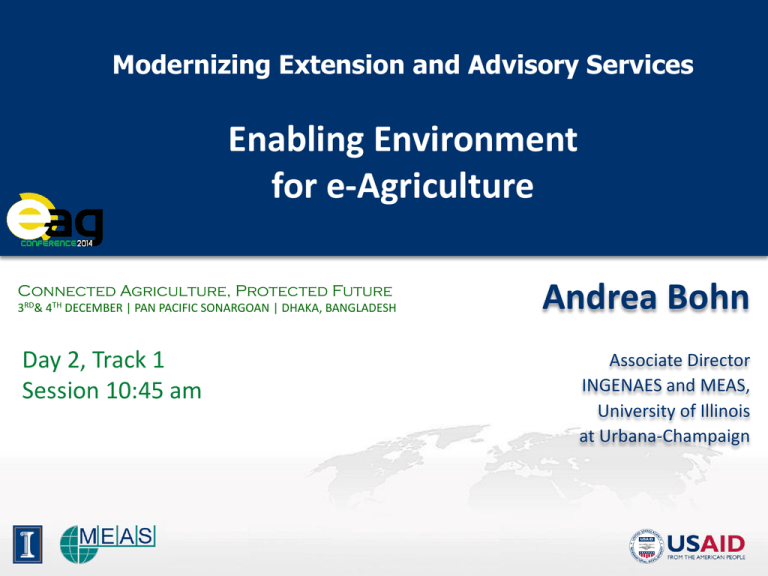
Modernizing Extension and Advisory Services Enabling Environment for e-Agriculture Connected Agriculture, Protected Future 3RD& 4TH DECEMBER | PAN PACIFIC SONARGOAN | DHAKA, BANGLADESH Day 2, Track 1 Session 10:45 am Andrea Bohn Associate Director INGENAES and MEAS, University of Illinois at Urbana-Champaign Agricultural Innovation System, AIS Informal institutions, practices and attitudes * Propensity for innovation and entrepreneurship * Political/bureaucratic culture * Trust * Attitudes towards risk * Learning orientation Agricultural research and education systems * Political channels * Stakeholder platforms * Media Agricultural Education System * Primary/secondary * Post-secondary * Vocational training Agricultural Extension System * Public sector * Private sector * NGO/PVO sector Agricultural Research System * Public sector * Private sector * NGO/PVO sector Agricultural Value Chain Actors & Organizations Bridging Institutions Integration in Value Chains Implementation/funding Influence/feed-back Agricultural Innovation Policies * Agricultural research policies * Agricultural extension policies * Agricultural education policies * Facilitation of actors and linkages Consumers Processing, Wholesale, Retail Traders Agricultural Producers (different categories) Input Suppliers * Seeds, fertilizer, pesticides, machinery, financial services Implementation/funding Influence/feed back General Agricultural Policies * Food policy * Rural infrastructure * Trade policies * Agricultural services * Taxation * Agricultural regulation * Facilitation * Property rights (land, IPR) The 3 P’s of Making it in ICT4AG • Perseverance • Pathways • Partnerships ICT4Ag Partnerships Content Sourcing Funding models/ Revenue sharing User/Client Provider Based on R. Kintu, Oct. 2014 The 4 C’s • cell phone coverage • broadband and bandwidth infrastructure; • electricity (cost and availability) Do you really know your clients? Clients • radio/TV stations – numbers, reach, governance Content • Are you targeting end user or intermediary? • Do you understand their needs, opportunities, barriers to access and use (language, literacy, gender, costs, trust, …)? • Do you engage with them from the getgo? Validation? COSTS vs. VALUE (to provider, to user, to society at large) Trusted? Reliable? Localized? Timely? Relevant? Actionable? • Are you actively pursuing user feedback? The 3 S’s Success • How do you know you are successful? By meeting donor expectations? Making profit? Reaching large scale? How do you define and measure impact? Higher incomes and improved food security at household, community, national level? (be careful what you measure) Scalability • Proof of concepts and pilots or design for scale from the getgo? Broad appeal or niche use? Is large scale equal to sustainability and profitability? Sustainability • How to reduce dependency on subsidy or donor support? • How to sustain responsiveness to client needs? This presentation was given by: Andrea Bohn on behalf of MEAS During the Plenary Session on Day 2 of “Connected Agriculture, Protected Future” Pan Pacific Sonargoan, Dhaka, Bangladesh on December 3-4, 2014 Terms of Use: © Andrea Bohn and MEAS project. This work is licensed under a Creative Commons Attribution 3.0 Unported License. Users are free: • to Share — to copy, distribute and transmit the work • to Remix — to adapt the work Under the following conditions: • Attribution — Users must attribute the work to the author(s)/institution (but not in any way that suggests that the authors/ institution endorse the user or the user’s use of the work). Disclaimer: This presentation was made possible by the generous support of the American people through the United States Agency for International Development, USAID. The contents are the responsibility of the author(s) and do not necessarily reflect the views of USAID or the United States Government. www.meas-extension.org The 3 P’s and more • Projects (donors, NGOs) • vs. programs (governments, multilateral donors) • vs. products (business approach)
